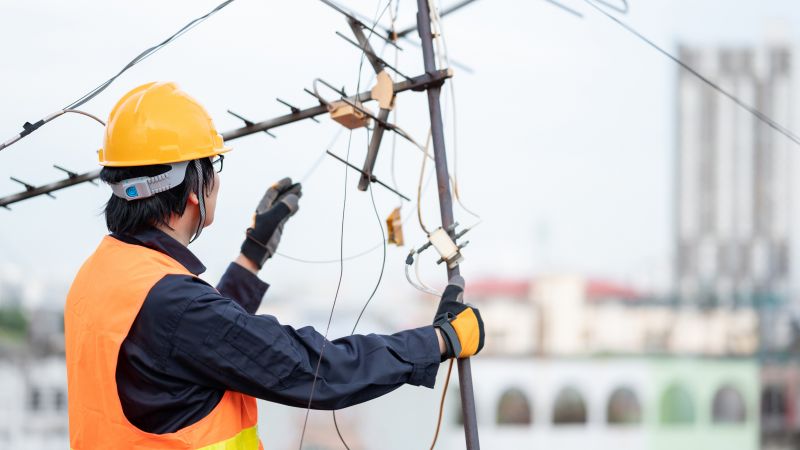Expert Picks For Antenna Removal Service Equipment
Browse through carefully selected tools designed to improve efficiency and safety in antenna removal services.
 Antenna removal services often require specialized tools and equipment to ensure the process is safe, efficient, and minimally invasive. Whether dealing with outdated, damaged, or unwanted antennas, having the right products can make the task significantly easier. These tools are designed to handle various types of antennas, including rooftop, satellite, and indoor models, providing versatility for different removal scenarios.
Antenna removal services often require specialized tools and equipment to ensure the process is safe, efficient, and minimally invasive. Whether dealing with outdated, damaged, or unwanted antennas, having the right products can make the task significantly easier. These tools are designed to handle various types of antennas, including rooftop, satellite, and indoor models, providing versatility for different removal scenarios.
Top Overall Option
Multi-Purpose Telescopic Antenna Removal Pole
A versatile telescopic pole designed for reaching high or difficult antennas safely. Constructed from lightweight yet durable materials, it offers adjustable length and compatibility with various attachments, making it suitable for both professional technicians and DIY users. Its ergonomic design enhances control and minimizes fatigue during extended use.
Types of Products For Antenna Removal Service
Extendable Telescopic Poles
Used to reach high antennas safely from the ground, these poles are adjustable and often compatible with various tools for cutting or disassembly.
Climbing Harnesses and Safety Gear
Essential for technicians working at heights, these harnesses provide secure support during antenna removal from rooftops or towers.
Cable Cutters and Wire Strippers
Specialized tools for safely cutting and stripping antenna cables, ensuring clean disconnections and reducing damage.
Heavy-Duty Hand Tools
Includes wrenches, screwdrivers, and pry bars designed for disassembling antenna mounts and brackets.
Antenna Removal Robots
Automated or remote-controlled devices that assist in removing antennas from hard-to-reach locations, enhancing safety and efficiency.
Protective Gloves and Eyewear
Personal safety equipment to protect against debris, sharp edges, and electrical hazards during removal.
Lifting and Hoisting Equipment
Cranes, hoists, and pulleys used for lifting heavy antennas safely from rooftops or towers.
Disposal and Recycling Bags
Specialized containers for safely collecting and transporting old antennas for recycling or disposal.
Grounding and Electrical Tools
Tools for safely disconnecting and grounding antennas to prevent electrical hazards.
Remote Monitoring Devices
Sensors and cameras to assist in assessing antenna conditions before removal, especially on tall structures.
Weatherproof Storage Cases
Durable containers for storing and transporting removal tools and parts in outdoor environments.
Mounting and Disassembly Kits
Complete sets of tools for disassembling various types of antenna mounts and brackets.
Popular Choices
Widely used for reaching high antennas safely, these poles are favored for their adjustable length and ease of use.
Commonly chosen for rooftop work, these harnesses provide secure support during removal tasks.
Popular for cleanly cutting antenna cables, these cutters are valued for their durability and precision.
A comprehensive set including wrenches, screwdrivers, and pry bars, essential for disassembly.
Increasingly used for hard-to-access antennas, these robots enhance safety and efficiency.
Gloves, goggles, and helmets are frequently selected to ensure safety during removal procedures.
Commonly used for heavy antennas, these hoists facilitate safe lifting from elevated positions.
Designed for easy collection and transport of old antennas, these bags are popular for cleanup tasks.
Tools for grounding antennas are frequently chosen to ensure safe disconnection from electrical sources.
Popular for outdoor work, these cases protect tools from weather elements during transportation.
Proper antenna removal is essential for maintaining building safety, preventing potential damage, and preparing for upgrades or replacements. The process can involve reaching high or difficult-to-access locations, which necessitates durable, reliable equipment. From extendable poles and climbing harnesses to specialized cutting tools and protective gear, a wide array of products is available to assist professionals and DIY enthusiasts alike.
Safety is paramount during antenna removal, especially when working at heights or with heavy components. Using high-quality equipment reduces the risk of accidents and ensures a smoother operation. Additionally, considering the specific type of antenna and the environment in which it is installed can influence the choice of tools. For example, lightweight, corrosion-resistant materials are ideal for outdoor use, while indoor removal might require more delicate instruments.
Investing in the right products not only streamlines the removal process but also helps preserve the integrity of the building structure and surrounding property. Proper disposal or recycling of old antennas is also an important aspect, often supported by specialized tools that facilitate safe handling. Overall, choosing suitable, well-designed products can make antenna removal safer, more efficient, and less labor-intensive.
Key Buying Considerations
- Compatibility with the specific type of antenna to ensure proper removal.
- Maximum reach and extension length of poles or lifting equipment for high installations.
- Material durability, especially resistance to corrosion and weather conditions.
- Ease of use and ergonomic design to reduce fatigue during extended operations.
- Safety features such as locking mechanisms, harness attachment points, and non-slip grips.
- Weight of tools and equipment for ease of handling and transportation.
- Versatility of tools to handle different removal scenarios and antenna types.
- Compatibility with additional attachments or accessories for enhanced functionality.
- Storage options for tools and parts, especially for outdoor or remote work sites.
- Disposal and recycling options for old antennas to comply with local regulations.
- Electrical safety features, such as grounding tools and insulated handles.
- Cost and value for money, considering durability and multi-purpose use.
- Availability of replacement parts and customer support from suppliers.
- Compliance with safety standards and regulations relevant to electrical and height work.
- User reviews and ratings to gauge real-world performance and reliability.
